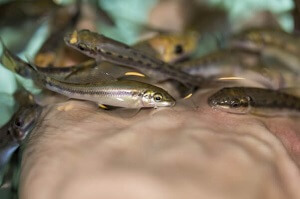How Much do Garra Rufa Fish Cost?
In recent years, the pedicure made with the help of Garra Rufa fishes, known also as Dr. Fishes, has become more and more popular all over the world. The Garra Rufa fish “eat” from the cuticles around the fingernails and toenails, constantly looking for areas where they can get “food”.
In Turkey, these fish are also used to treat psoriasis, eczema, or hard skin on the feet. The therapeutic effect is due to an enzyme secreted in their saliva, diethanol, which has healing properties.
How Much do Garra Rufa Fish Cost?
A Garra Rufa fish costs anywhere between $5 and $16, depending on the place you buy it from, the type of fish, and the quantity. For instance, a Garra Rufa Obtuse would cost you anywhere between $10 and $15 per fish.
According to a member of the allaquariuminfo.com forum, the price of this doctor fish is around $6.
In case you want to go to a spa or a salon for a massage that includes Garra Rufa fishes, you should be prepared to pay anywhere between $35 and $55 for a fifteen-to-twenty-minute session.
Garra Rufa fish overview
Garra Rufa fishes are native to the warm waters around the city of Kangal in Turkey, feeding normally on plankton. Since this source of food is hard to find in the natural environment, fishes have modified their culinary tastes, nibbling the dead skin cells from the human body.
The Garra Rufa Fish pedicure involves immersing your feet in water filled with tiny pet fish that eat away dead tissues. These pedicure fish are known for their ability to exfoliate and eat dead skin without harming healthy skin in any way. Garra Rufa fish do not have teeth, so they do not bite to remove dead skin from their feet. Imagine these fish as thousands of tiny underwater vacuum cleaners attached to your feet.
You might also like our articles about the cost of cuttlefish, marlin fish, or crawfish.
Even with the vacuum cleaner analogy above, it might be hard to imagine exactly what a fish pedicure feels like. For some people, the sensation may be ordinary. And customers report that their feet feel softer and cleaner after this experience. Some people laugh until they cry and can’t believe they can buy this.
Which are the additional expenses?
 Similar to owning any other fish, you will have to get all the necessary startup supplies, which would include a fish aquarium or tank which costs around $40, lighting which is $13, and a filter which is $25. The ideal setup list for Garra Rufa fish will include an air pump, a water pump filter, an ozone system, and a UV filter. For the tank, you should plan on a minimum of one gallon per inch.
Similar to owning any other fish, you will have to get all the necessary startup supplies, which would include a fish aquarium or tank which costs around $40, lighting which is $13, and a filter which is $25. The ideal setup list for Garra Rufa fish will include an air pump, a water pump filter, an ozone system, and a UV filter. For the tank, you should plan on a minimum of one gallon per inch.
It is highly recommended to have heaters in the tanks because Garra Rufa fishes are considered tropical.
You will have to purchase fish food every few months. This should cost you less than $10. Flakes will be enough as these fishes come from a place with very little food.
Most fishes are available through online ordering and importing, so you will have to budget for shipping fees as well. At some stores, this fee would be around $13 per fish.
These spa fishes prefer to be in groups of a minimum of six to twelve fishes, so you should plan on purchasing more than just one fish.
Important things about the pedicure fish
These fish can help stimulate blood flow, improve circulation, stimulate acupuncture points, relieve foot odor, and treat fungal infections. But none of these benefits have been scientifically proven. A small 2006 study found that using fish to treat psoriasis along with ultraviolet radiation was a viable treatment option with few adverse effects, but the effectiveness of Garra Rufa fish alone was not tested.
However, not everyone appreciates Garra Rufa treatments. In 14 USA states, this practice was banned. The authorities in the American states have come to the conclusion that the health of clients who use this type of pedicure can be put at risk.
Fishes cannot be sterilized. Thus, they touch several feet from different people in the same water. The risk of transmitting skin infections is huge. They can become carriers of streptococcal bacteria. The bacteria and the water where the fish live make pedicures dangerous for people who have cuts or scratches, diabetes, liver disease, and a deficient immune system.
Because these fish are not found everywhere, being native to Turkey, Jordan, Iran, and other parts of Eurasia, they pose a risk to wild ecosystems. The size and diet of the fish could compete with native wild species. This means that if the fish were to enter the water, they could take away the food source of other fish, disrupting the balance of the ecosystem.



Leave a Reply
Want to join the discussion?Feel free to contribute!